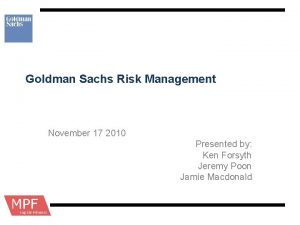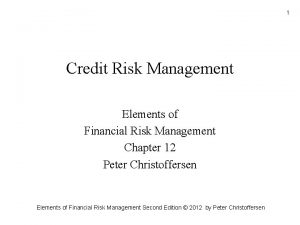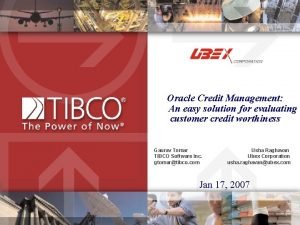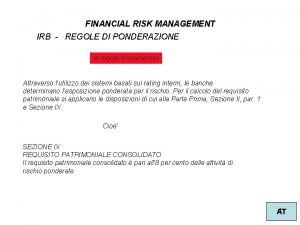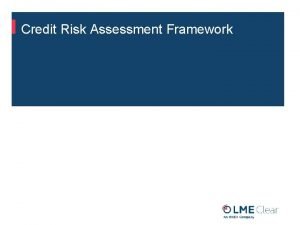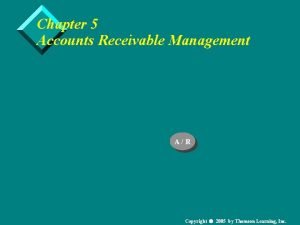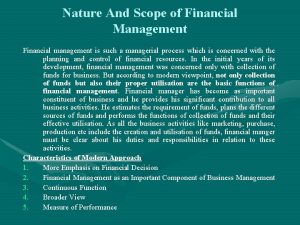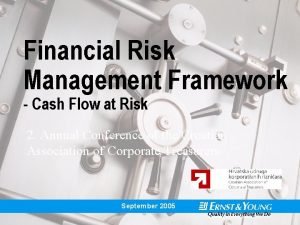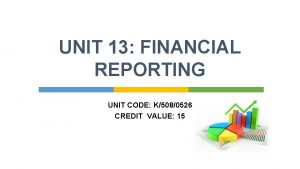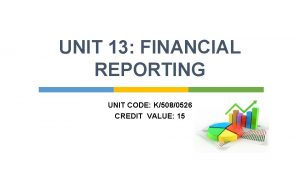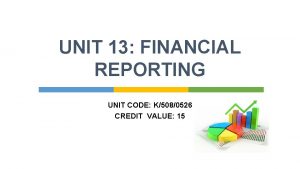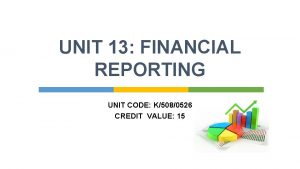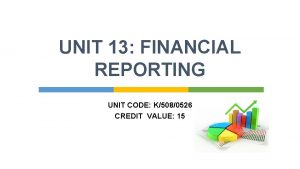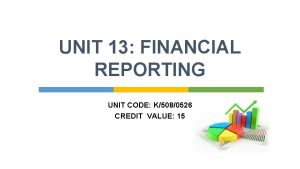UNIT 15 FINANCIAL MANAGEMENT Unit code M5080527 Credit




































![REFERENCES �Apm. org. uk. (2018). What is investment appraisal? | APM. [online] Available at: REFERENCES �Apm. org. uk. (2018). What is investment appraisal? | APM. [online] Available at:](https://slidetodoc.com/presentation_image_h2/4cddfc1cb1eb701bedd9a95a8de8105b/image-37.jpg)

![REFERENCES �principlesofaccounting. com. (2018). The Trial Balance - principlesofaccounting. com. [online] Available at: https: REFERENCES �principlesofaccounting. com. (2018). The Trial Balance - principlesofaccounting. com. [online] Available at: https:](https://slidetodoc.com/presentation_image_h2/4cddfc1cb1eb701bedd9a95a8de8105b/image-39.jpg)
- Slides: 39

UNIT 15: FINANCIAL MANAGEMENT Unit code M/508/0527 Credit value 15

UNIT 15: FINANCIAL MANAGEMENT �Learning Outcome 3: Evaluate the role of management accountants and accounting control systems.

THE BASIC SYLLABUS � 1 Apply different approaches used to support effective decision-making. � 2 Analyse financial management principles which are used to support effective financial strategies. � 3 Evaluate the role of management accountants and accounting control systems. � 4 Evaluate ways in which financial decision-making supports sustainable performance.

LEARNING OUTCOMES LO 4: Evaluate ways in which financial decision-making supports sustainable performance. M 4: Critically evaluate how different ways of financial decision making supporting long term financial sustainability

OVERVIEW � Investment appraisal is a collection of techniques used to identify the attractiveness of an investment. �The purpose of investment appraisal is to assess the viability of project, programme or portfolio decisions and the value they generate. In the context of a business case, the primary objective of investment appraisal is to place a value on benefits so that the costs are justified.

INVESTMENT APPRAISAL TECHNIQUE �Before committing to high levels of capital spend, companies normally undertake investment appraisal. �Investment appraisal has the following features: �- assessment of the level of expected returns earned for the level of expenditure made �- estimates of future costs and benefits over the project's life. �When a proposed capital project is evaluated, the costs and benefits of the project should be evaluated over its foreseeable life. This is usually the expected useful life of the non-current asset to be purchased, which will be several years. This means that estimates of future costs and benefits call for long-term forecasting.

INVESTMENT APPRAISAL TECHNIQUE �A 'typical' capital project involves an immediate purchase of a non-current asset. The asset is then used for a number of years, during which it is used to increase sales revenue or to achieve savings in operating costs. There will also be running costs for the asset. At the end of the asset's commercially useful life, it might have a 'residual value'. For example, it might be sold for scrap or in a second-hand market. (Items such as motor vehicles and printing machines often have a significant residual value. )

INVESTMENT APPRAISAL TECHNIQUE �A problem with long-term forecasting of revenues, savings and costs is that forecasts can be inaccurate. However, although it is extremely difficult to produce reliable forecasts, every effort should be made to make them as reliable as possible. �A business should try to avoid spending money on non-current assets on the basis of wildly optimistic and unrealistic forecasts. �The assumptions on which the forecasts are based should be stated clearly. If the assumptions are clear, the forecasts can be assessed for reasonableness by the individuals who are asked to authorise the spending.

INVESTMENT APPRAISAL TECHNIQUE �Two basic appraisal techniques covered here are Return on Capital Employed (ROCE) and Payback. �There are other more sophisticated methods of investment appraisal such as Net Present Value (NPV) and Internal Rate of Return (IRR). Cost control and reduction refers to the efforts business managers make to monitor, evaluate, and trim expenditures. These efforts might be part of a formal, company -wide program or might be informal in nature and limited to a single individual or department. In either case, however, cost control is a particularly important area of focus for small businesses, which often have limited amounts of time and money.

NET PRESENT VALUE (NPV) �“Net present value is the present value of the cash flows at the required rate of return of your project compared to your initial investment, ” says Knight. In practical terms, it’s a method of calculating your return on investment, or ROI, for a project or expenditure. By looking at all of the money you expect to make from the investment and translating those returns into today’s dollars, you can decide whether the project is worthwhile.

NET PRESENT VALUE (NPV) �When a manager needs to compare projects and decide which ones to pursue, there are generally three options available: internal rate of return, payback method, and net present value. Knight says that net present value, often referred to as NPV, is the tool of choice for most financial analysts. There are two reasons for that. One, NPV considers the time value of money, translating future cash flows into today’s dollars. Two, it provides a concrete number that managers can use to easily compare an initial outlay of cash against the present value of the return.

NET PRESENT VALUE (NPV) �Managers also use NPV to decide whether to make large purchases, such as equipment or software. It’s also used in mergers and acquisitions (though it’s called the discounted cash flow model in that scenario). In fact, it’s the model that Warren Buffet uses to evaluate companies. Any time a company is using today’s dollars for future returns, NPV is a solid choice.

NET PRESENT VALUE (NPV) �The management of Fine Electronics Company is considering to purchase an equipment to be attached with the main manufacturing machine. The equipment will cost $6, 000 and will increase annual cash inflow by $2, 200. The useful life of the equipment is 6 years. After 6 years it will have no salvage value. The management wants a 20% return on all investments. �Required: �Compute net present value (NPV) of this investment project. �Should the equipment be purchased according to NPV analysis?

NET PRESENT VALUE (NPV) � Solution: � Computation of Net Present value: *Value from “present value of an annuity of $1 in arrears table“.

NET PRESENT VALUE (NPV) �Yes, the equipment should be purchased because the net present value is positive ($1, 317). Having a positive net present value means the project promises a rate of return that is higher than the minimum rate of return required by management (20% in the above example). �In the above example, the minimum required rate of return is 20%. It means if the equipment is not purchased and the money is invested elsewhere, the company would be able to earn 20% return on its investment. The minimum required rate of return (20% in our example) is used to discount the cash inflow to its present value and is, therefore, also known as discount rate.

INTERNAL RATE OF RETURN (IRR) �Financial ratios as consisting of five basic types: �Profitability ratios measure the firm’s use of its assets and control of its expenses to generate an acceptable rate of return. �Liquidity ratios measure the availability of cash to pay debt. �Activity ratios, also called efficiency ratios, measure the effectiveness of a firm’s use of resources, or assets. �Debt, or leverage, ratios measure the firm’s ability to repay long -term debt. �Market ratios are concerned with shareholder audiences. They measure the cost of issuing stock and the relationship between return and the value of an investment in company’s shares.

RETURN OF CAPITAL EMPLOYED (ROCE) �ROCE is also known as accounting rate of return (ARR).

RETURN OF CAPITAL EMPLOYED (ROCE) �The initial capital cost could comprise any or all of the following: �cost of new assets bought �net book value (NBV) of existing assets to be used in the project �investment in working capital �capitalised R&D expenditure Decision rule �The decision rule for ROCE is: �If the expected ROCE for the investment is greater than the target or hurdle rate (as decided by management) then the project should be accepted.

RETURN OF CAPITAL EMPLOYED (ROCE) Advantages and disadvantages of ROCE �Advantages of ROCE as an investment appraisal technique include: �simplicity �links with other accounting measures. Disadvantages include: �no account is taken of project life �no account is taken of timing of cash flows �it varies depending on accounting policies �it may ignore working capital �it does not measure absolute gain �there is no definitive investment signal.

PAYBACK PERIODS �The payback period is the time a project will take to pay back the money spent on it. It is based on expected cash flows and provides a measure of liquidity.

PAYBACK PERIODS �Decision rule �When using Payback, the company must first set a target payback period. �Select projects which pay back within the specified time period. �Choose between options on the basis of the fastest payback

PAYBACK PERIODS �Example using Payback �Constant annual cash flows �An expenditure of $2 million is expected to generate net cash inflows of $500, 000 each year for the next seven years. �What is the payback period for the project?

PAYBACK PERIODS �Advantages include: • it is simple • it is useful in certain situations: • rapidly changing technology • improving investment conditions • it favours quick return: • helps company growth • minimises risk • maximises liquidity • it uses cash flows, not accounting profit.

PAYBACK PERIODS �Disadvantages include: • it ignores returns after the payback period • it ignores the timings of the cash flows. This can be resolved using the discounted payback period. • it is subjective as it gives no definitive investment signal • it ignores project profitability.

RETURN ON INVESTMENTS �Return on investment (ROI) is the ratio of profit made in a financial year as a percentage of an investment. In other words, ROI reveals the overall benefit (return) of an investment using the gain or loss from the investment along with the cost of the investment. �Return on investment is a useful and simple measure of how effective a company generates profits from an investment. Many firms use ROI as a convenient tool to compare the benefit of an investment with the cost of the investment. For example, if a company effectively utilizes an investment and produces gains, ROI will both be high.

RETURN ON INVESTMENTS �Whereas if a company ineffectively utilizes an investment and produces losses, ROI will be low. For investors, choosing a company with a good return on investment is important because a high ROI means that the firm is successful at using the investment to generate high returns. Investors will typically avoid an investment with a negative ROI, or if there are other investment opportunities with a positive ROI. Return on investment models are used often because the ROI ratio and inputs can be modified to fit different companies and financial situations.

RETURN ON INVESTMENTS �The return on investment ratio calculates the percentage return (profitability) on an investment. Check out the following ROI formula: �Simple Return on Investment Ratio = (Earnings from Investment – Cost of Investment) ÷ Cost of Investment �For example, this year, ABC company has produced earnings of $50, 000 from an investment. The cost of the investment was $30, 000. �Simple Return on Investment Ratio = ($50, 000 – $30, 000) ÷ $30, 000 = 67% �Based on the result, we assume that ABC company has an annual percentage return on investment of 67%. The benefit (gain) was $50, 000 and the investment cost was $30, 000.

CASHFLOW STATEMENTS �A Cash Flow Statement (also called the Statement of Cash Flows) shows how much cash is generated and used during a given time period. It is one of the main financial statements analysts use in building a three statement model. The main categories found in a cash flow statement are the: � (1) operating activities, � (2) investing activities and � (3) financing activities of a company and are organized respectively as mentioned.

CASHFLOW STATEMENTS �The total cash provided from or used by each of the three activities will be summed to arrive at the total change in cash for the period, and then combined with the opening cash balance to arrive at the cash flow statement’s bottom line, the closing cash balance.

CASHFLOW STATEMENTS

CASHFLOW STATEMENTS

TRIAL BALANCES �The trial balance is an internal report run at the end of an accounting period, listing the ending balance in each account. The report is primarily used to ensure that the total of all debits equals the total of all credits, which means that there are no unbalanced journal entries in the accounting system that would make it impossible to generate accurate financial statements. The year-end trial balance is typically asked for by auditors when they begin an audit, so that they can transfer the account balances on the report into their auditing software; they may ask for an electronic version, which they can more easily copy into their software.

TRIAL BALANCES �Even when the debit and credit totals stated on the trial balance equal each other, it does not mean that there are no errors in the accounts listed in the trial balance. For example, a debit could have been entered in the wrong account, which means that the debit total is correct, though one underlying account balance is too low and another balance is too high. For example, an accounts payable clerk records a $100 supplier invoice with a debit to supplies expense and a $100 credit to the accounts payable liability account. The debit should have been to the utilities expense account, but the trial balance will still show that the total amount of debits equals the total number of credits.

TRIAL BALANCES

BREAKEVEN �Understanding the company’s break-even point is important to small- business owners. Many owners desire to know how much they need to achieve in sales to realize a profit. The components of break-even analysis include sales revenue, fixed and variable costs, and the contribution margin. You should understand the components of the break-even point to determine how much your company needs to achieve in total sales or unit sales to break even. The break-even point helps managers make important business decisions to achieve the company's desired income.

BREAKEVEN �The break-even point determines the amount of sales needed to achieve a net income of zero. It shows the point when a company’s revenue equals total fixed costs plus variable costs, and its fixed costs equal the contribution margin. To calculate the break-even point in sales dollars, you must divide total fixed costs by the contribution margin ratio. For example, the break-even point is $1, 000 for a company with $500, 000 in fixed costs and a contribution ratio of 50 percent. This means that if the company earns $1, 000 in revenue, it can cover its expenses but does not earn a profit.
![REFERENCES Apm org uk 2018 What is investment appraisal APM online Available at REFERENCES �Apm. org. uk. (2018). What is investment appraisal? | APM. [online] Available at:](https://slidetodoc.com/presentation_image_h2/4cddfc1cb1eb701bedd9a95a8de8105b/image-37.jpg)
REFERENCES �Apm. org. uk. (2018). What is investment appraisal? | APM. [online] Available at: https: //www. apm. org. uk/body-ofknowledge/delivery/financial-cost-management/investment-appraisal/ [Accessed 7 Apr. 2018]. � Kfknowledgebank. kaplan. co. uk. (2018). [online] Available at: http: //kfknowledgebank. kaplan. co. uk/KFKB/Wiki%20 Pages/Basic%20 inve stment%20 appraisal%20 techniques. aspx [Accessed 7 Apr. 2018]. �Harvard Business Review. (2018). A Refresher on Net Present Value. [online] Available at: https: //hbr. org/2014/11/a-refresher-on-net-present -value [Accessed 7 Apr. 2018].

REFERENCES �Accounting for Management. (2018). Net present value (NPV) method - explanation, example, assumptions, advantages, disadvantages | Accounting for Management. [online] Available at: https: //www. accountingformanagement. org/net-present-value-method/ [Accessed 7 Apr. 2018]. �Wilkinson, J. (2018). Return on Investment (ROI) Definition | How to Find Return on Investment. [online] The Strategic CFO. Available at: https: //strategiccfo. com/return-investment-roi/ [Accessed 7 Apr. 2018]. �Corporate Finance Institute. (2018). Cash Flow Statement - How a Statement of Cash Flows Works. [online] Available at: https: //corporatefinanceinstitute. com/resources/knowledge/accounting/ cash-flow-statement%E 2%80%8 B/ [Accessed 7 Apr. 2018].
![REFERENCES principlesofaccounting com 2018 The Trial Balance principlesofaccounting com online Available at https REFERENCES �principlesofaccounting. com. (2018). The Trial Balance - principlesofaccounting. com. [online] Available at: https:](https://slidetodoc.com/presentation_image_h2/4cddfc1cb1eb701bedd9a95a8de8105b/image-39.jpg)
REFERENCES �principlesofaccounting. com. (2018). The Trial Balance - principlesofaccounting. com. [online] Available at: https: //www. principlesofaccounting. com/chapter-2/the-trial-balance/ [Accessed 7 Apr. 2018]. � Bragg, S. and Bragg, S. (2018). The trial balance | Example | Format. [online] Accounting. Tools. Available at: https: //www. accountingtools. com/articles/2017/5/16/the-trial-balanceexample-format [Accessed 7 Apr. 2018]. � Smallbusiness. chron. com. (2018). What Does the Break-Even Point Mean & What Does a Firm Need to Do to Achieve a Break-Even? . [online] Available at: http: //smallbusiness. chron. com/breakeven-point-mean-firm -need-achieve-breakeven-38264. html [Accessed 7 Apr. 2018].
 Busceral
Busceral This can be avoided by giving credit where credit is due.
This can be avoided by giving credit where credit is due. Financial management subject code
Financial management subject code 3-6 credit card statement answers
3-6 credit card statement answers Best financial credit union
Best financial credit union Financial and non financial methods of motivation
Financial and non financial methods of motivation Oracle credit management application
Oracle credit management application Credit union erm
Credit union erm Credit risk management and advisory goldman sachs
Credit risk management and advisory goldman sachs Cost of granting credit
Cost of granting credit Dispute management in order to cash
Dispute management in order to cash Credit risk
Credit risk Christoffersen elements of financial risk management
Christoffersen elements of financial risk management Airplus portal
Airplus portal Cost of receivables
Cost of receivables Oracle credit checklists
Oracle credit checklists Metodo irb
Metodo irb Credit risk evaluation framework
Credit risk evaluation framework Credit standards in receivable management
Credit standards in receivable management Credit unit
Credit unit Managing credit unit test
Managing credit unit test Code élaboré code restreint
Code élaboré code restreint Managed and unmanaged code
Managed and unmanaged code Apa itu assembler
Apa itu assembler Difference between source code and machine code
Difference between source code and machine code Code mixing and code switching
Code mixing and code switching Trace the code genetic code table
Trace the code genetic code table Scientific management
Scientific management Management pyramid
Management pyramid Top management and middle management
Top management and middle management Unit 10, unit 10 review tests, unit 10 general test
Unit 10, unit 10 review tests, unit 10 general test Retail financial strategy
Retail financial strategy What is meant by issue management
What is meant by issue management Scope of strategic management
Scope of strategic management The nature of financial management
The nature of financial management Scheduled banks vs non scheduled banks
Scheduled banks vs non scheduled banks Six phases of public financial management
Six phases of public financial management International financial management 13th edition
International financial management 13th edition What is financial risk 1
What is financial risk 1 Cash flow at risk
Cash flow at risk








